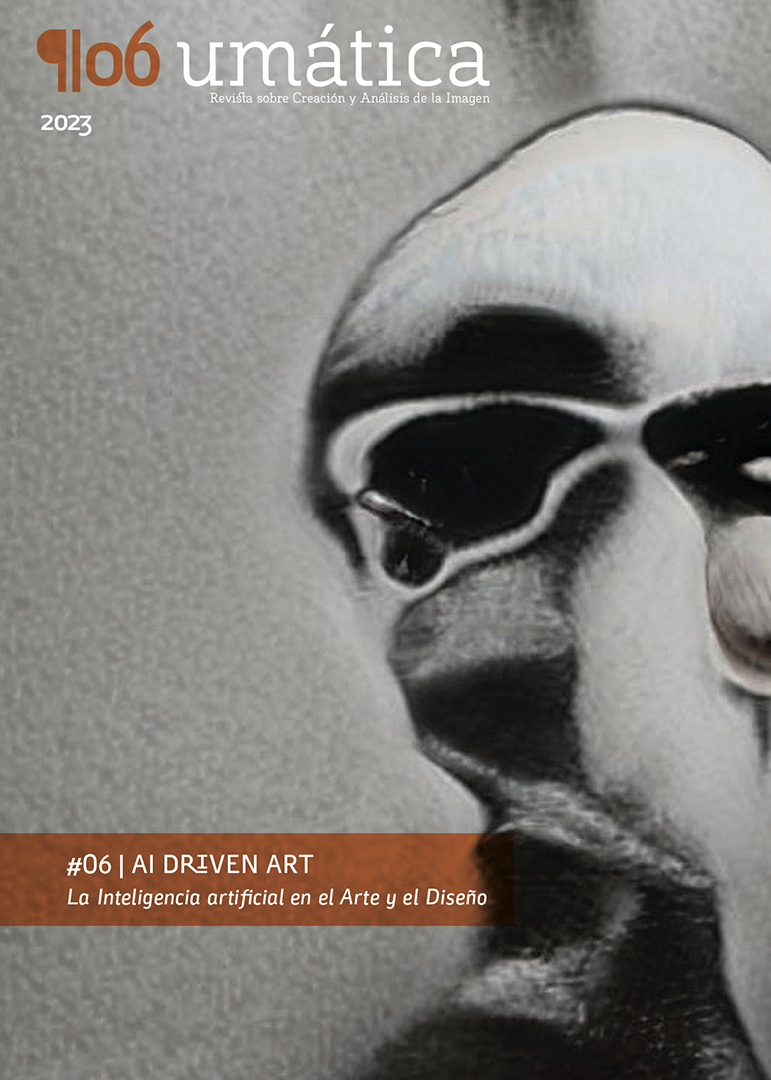Generative Artificial Intelligence in the Creative Process and Design Concept Development
DOI:
https://doi.org/10.24310/umatica.2023.v5i6.17153Keywords:
Generative artificial intelligence, Instructions - keywords (prompts), Product design, Learning algorithm, Creative process.Abstract
The presence of Artificial Intelligence has become increasingly common in the professional field of designers. This technology stands out for its efficiency and capability, surpassing specialists expectations during their creative process. In this article, we review the achievements obtained during the concept generation for academic design projects using different generative platforms for text and image by artificial intelligence. At the Center for Industrial Design Research (CIDI) of the National Autonomous University of Mexico, these generative image systems were used in two courses, yielding favorable basic results in formal and aesthetic configuration. These results served as the foundation for developing a methodology, scope, and guidelines to achieve image generation through the automatic training of an artificial intelligence based on language and conversation models.
Downloads
Metrics
Publication Facts
Reviewer profiles N/A
Author statements
Indexed in
-
—
- Academic society
- N/A
- Publisher
- Universidad de Málaga (España)
References
Aso, N., Yanami, H., y Ogawa, M. (2022). Automatic Parametric Modeling Technique for Structural Design Standardization. IEEE Access, 10, 81031–81041. doi:10.1109/ACCESS.2022.3196001
Craiyon. (2023 Junio 20). Craiyon, AI Image Generator de https://www.craiyon.com/
Figoli, F. A., Mattioli, F., y Rampino, L. (2022). Artificial intelligence in the design process: The Impact on Creativity and Team Collaboration. FrancoAngeli.
Flick, C., y Worrall, K. (2022). The Ethics of Creative AI. C. Vear & F. Poltronieri (Eds.), The Language of Creative AI: Practices, Aesthetics and Structures, 73–91. doi:10.1007/978-3-031-10960-7_5
Guilford, J. P. (1950). Creativity. American Psychologist 5, 444–454.
Guzdial, M., y Riedl, M. (2019). An Interaction Framework for Studying Co-Creative AI. arXiv [Cs.HC]. Recuperado de http://arxiv.org/abs/1903.09709
Kocaballi, A. B. (2023). Conversational AI-Powered Design: ChatGPT as Designer, User, and Product. arXiv [Cs.HC]. Recuperado de http://arxiv.org/abs/2302.07406
Liu, V., y Chilton, L. B. (2022). Design Guidelines for Prompt Engineering Text-to-Image Generative Models. Proceedings of the 2022 CHI Conference on Human Factors in Computing Systems. New Orleans, LA, Estados Unidos. doi:10.1145/3491102.3501825
Midjourney. (2023 Junio 20). Midjourney de https://www.midjourney.com/
Nadimpalli, M. (2017). Artificial intelligence risks and benefits. International Journal of Innovative Research in Science, Engineering and Technology, 6(6).
Norvig, P., y Russell, S. (2021) - Cambiar por: Russell, S.J y Norvig, P. (2021) Inteligencia Artificial. Un Enfoque Moderno Edición Global (4ta Edición), México. Pearson. https://www.ingebook.com/ib/NPcd/IB_BooksVis?cod_primaria=1000187&codigo_libro=11047
Nozaki, N., Konno, E., Sato, M., Sakairi, M., Shibuya, T., Kanazawa, Y., y Georgescu, S. (2017). Application of artificial intelligence technology in product design. Fujitsu Sci. Tech. J, 53(4), 43–51.
Oosthuizen, K., Botha, E., Robertson, J., y Montecchi, M. (2021). Artificial intelligence in retail: The AI-enabled value chain. Australasian Marketing Journal, 29(3), 264–273. doi:10.1016/j.ausmj.2020.07.007
OpenAI. (2023 Junio 20) ChatGPT de https://chat.openai.com/
Oppenlaender, J. (2022). The Creativity of Text-to-Image Generation. Proceedings of the 25th International Academic Mindtrek Conference, 192–202. Finland. doi:10.1145/3569219.3569352
Programa de las Naciones Unidas para el Desarrollo PNUD. (2023). Programa de las Naciones Unidas para el Desarrollo PNUD, Objetivos de desarrollo sostenible de https://www.undp.org/es/sustainable-development-goals
Rezwana, J., y Maher, M. L. (2023). Designing Creative AI Partners with COFI: A Framework for Modeling Interaction in Human-AI Co-Creative Systems. ACM Trans. Comput. -Hum. Interact., 30(5). doi:10.1145/3519026
Ribot, Th. (1901). Ensayo acerca de la imaginación creadora. 24 - 26 Recuperado de: http://cdigital.dgb.uanl.mx/la/1020024845/1020024845.html
Vallor, S. (2016). Technology and the virtues: A philosophical guide to a future worth wanting. Oxford University Press.
Vartiainen, H., y Tedre, M. (2023). Using artificial intelligence in craft education: crafting with text-to-image generative models. Digital Creativity, 34(1), 1–21. doi:10.1080/14626268.2023.2174557
Tsang, Y. P., y Lee, C. K. M. (2022). Artificial intelligence in industrial design: A semi-automated literature survey. Engineering Applications of Artificial Intelligence, 112, 104884. doi:10.1016/j.engappai.2022.104884
World Design Organization (2023 Junio 20) Achieving the sustainable development goals by design, de https://sdgs.un.org/goals
Wei Xu, L. G., Marvin J. Dainoff, y Gao, Z. (2023). Transitioning to Human Interaction with AI Systems: New Challenges and Opportunities for HCI Professionals to Enable Human-Centered AI. International Journal of Human–Computer Interaction, 39(3), 494–518. doi:10.1080/10447318.2022.2041900
Zhang, J., y Yu, H. (2023). EID: Facilitating Explainable AI Design Discussions in Team-Based Settings. International Journal of Crowd Science, 7(2), 47–54. doi:10.26599/IJCS.2022.9100034
Zhu, Q., y Luo, J. (2022). Generative Pre-Trained Transformer for Design Concept Generation: An Exploration. Proceedings of the Design Society, 2, 1825–1834. doi:10.1017/pds.2022.185
Downloads
Published
How to Cite
Issue
Section
License
Copyright (c) 2023 Vanessa Sattele, Mauricio Reyes, Andrés Fonseca

This work is licensed under a Creative Commons Attribution-NonCommercial-ShareAlike 4.0 International License.
All contens publishes in Umática.Revista sobre Creación y Anáisis de la Imágen are protected under the Creative Commos Attribution-NonComercial-ShareAlike 4.0 International (CC-BY-NC-SA 4.0) license.
All about this license is available in the following link: <http://creativecommons.org/licenses/by-nc-sa/4.0>
Users can copy, use, redistribute, share and exhibit publicly as long as:
- The original source and authorship of the material are cited (Journal, Publisher and URL of the work).
- It is not used for comercial purposes.
- The existence of the license and its especifications are mentioned.
There are two sets of authors’ rights: moral and property rights. Moral rights are perpetual prerogatives, unrenounceable, not-transferable, unalienable, imprescriptible and inembargable. According to authors’ rights legislation, Umática.Revista sobre Creación y Anáisis de la Imágen recognizes and respects authors moral rights, as well as the ownership of property rights, which will be transferred to University of Malaga in open access. The property rights are referred to the benefits that are gained by the use or the dissemination of works. Fotocinema. Umática.Revista sobre Creación y Anáisis de la Imágen is published in an open access form and it is exclusively licenced by any means for doing or authorising distribution, dissemination, reproduction, , adaptation, translation or arrangement of works.
Authors are responsable for obtaining the necessary permission to use copyrighted images.
Copyright note: Authors who have publications with this journal agree and certify to the following terms:
- That he/she has contributed directly to the intellectual content of the work, for which he/she is responsible for all purposes.
- That he/she approves the contents of the manuscript submitted to the editorial process of UMÁTICA, REVISTA SOBRE CREACIÓN Y ANÁLISIS DE LA IMAGEN, and therefore agrees that his/her name appears as the author(s).
- That the content of the article has not been published and that it does not appear in any other work that is about to be published.
- That he/she agrees not to submit it for consideration of another publication while it is in the process of being reviewed by UMÁTICA, REVISTA SOBRE CREACIÓN Y ANÁLISIS DE LA IMAGEN, nor later in case it is accepted for publication.
- That he/she has not had, nor does any personal or financial affiliations that could prejudice the development or results of the present work.
- That all those persons who have made a substantial contribution to the development of the work, having given their permission for the mention, have been mentioned in the acknowledgments section.
- That he/she agrees to provide, when required by the journal, access to all the data and sources on which the work presented is based.
- That he/she will actively participate in the realization of all those stylistic or orthographic-typographic modifications necessary for the publication of the work when notified by the journal's editorial team.
- That he/she has not violated, and nor will, the laws and human or animal rights during the process of research and publication of this work.
- That, none of the institutions in which he/she carries out his/her scientific and research work has presented objections to the publication of the manuscript submitted for evaluation.
- That data and references to materials published are credited and included in the references and citations and, in the cases required, have the due authorizations of those who own the patrimonial rights.
- That any material used is free of copyright. Author(s) is responsible for any litigation or claim related to intellectual property rights, exonerating UMÁTICA, REVISTA SOBRE CREACIÓN Y ANÁLISIS DE LA IMAGEN (UMÁTICA, CREATION AND ANALYSIS OF IMAGE JOURNAL) of any responsibility.
- That in case the work is approved for publication, authorizes the publisher to include the text in the journal UMÁTICA, REVISTA SOBRE CREACIÓN Y ANÁLISIS DE LA IMAGEN and to reproduce, edit, distribute, exhibit and communicate it in the country and abroad by printed, electronic, CD, Internet or any other means known or to be known.







23.png)






